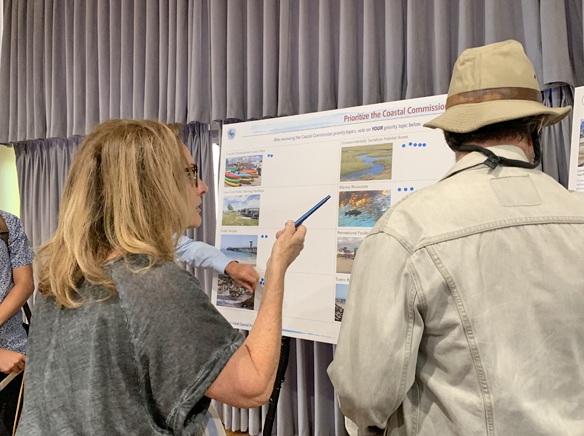
Is maintaining public access to the beach important? How about protecting marine resources? Or preparing for sea level rise? These were some of the priorities discussed last week at the city of Seal Beach’s third public meeting in its effort to develop a Local Coastal Program, or LCP.
If certified by the California Coastal Commission, an LCP can give the city more control over some development projects in the city’s coastal zone, an area that covers nearly everything between the beach boardwalk and Westminster Boulevard. For example, the LCP could potentially streamline the permitting process required for remodeling your house.
Only a handful of residents attended the August 21 Goals and Policy Workshop held at the Marina Community Center. The few participants were asked to give feedback about what should be focused on in the city’s LCP.
The meeting started with a brief presentation from Noelle Steele, a project planner with Michael Baker International, the consultant hired to draft the LCP for the city.
Participants then visited four different stations to offer input. At one, a large poster board listed eight priority topics the California Coastal Commission requires LCP’s to address. Residents were asked to use stickers to vote on which priorities they thought were most important to Seal Beach. There were no apparent rules on how many stickers each person could use.
“I’m encouraged that [Sea Level Rise] is on the board,” said Sylvia Schoelkopf, a Seal Beach resident on the Hill who said she was concerned with how increased flooding could impact her home. While sea level rise got a sticker from her, and the most of any category that night, she was also interested in prioritizing the protection of marine resources and environmentally sensitive habitat areas. “We lose part of our character if we lose that,” she said.
The other CCC priority topics were: coastal development land uses, low-cost visitor serving facilities, public access, recreational facilities and scenic resources.
At another station, people wrote on post-it notes to explain their “aspirations for the future of the Seal Beach coastal zone.” Many expressed a desire to limit high-density development and to keep Seal Beach’s small-town feel. Others emphasized the need to prepare for sea level rise.
Residents also did what’s known as a S.W.O.T. analysis on the city’s coastal zone using post-it notes to identify its strengths, weaknesses, opportunities and threats.
The last station asked people to create a mock LCP where you match a goal, like reducing trash on the beach, with a proposed policy, such as engaging with stakeholders in cities along the San Gabriel River, a source of debris that washes ashore.
At least three of the participants interviewed expressed concern that the input from last Wednesday’s meeting would skew how the LCP was developed since so few people attended.
“This was such a bad showing,” Jean Orland of College Park East said and added, “There really wasn’t any input.” Orland said more people need to be involved in this process especially when it comes to sea level rise.
Orland was one of about 40 people who attended a meeting last month on sea level rise and the LCP. In April, the city hosted a pop-up booth on the LCP at the Car Show.
“We have had 3 meetings and over 250 people have provided input thus far,” Steven Fowler, Interim Director of Community Development for Seal Beach wrote in an email message to The Sun.
The city also previously held separate meetings with twelve different community stakeholders like the Chamber of Commerce, Boeing, The Seal Beach Lions Club and others.
Fowler said there is still time for people to voice their opinions by emailing him at sfowler@sealbeachca.gov or calling (562) 431-2527 x1316.
“We really welcome the comments and questions that we have received so far and hope that more residents will take the time to share their thoughts with us as we progress towards developing an LCP.”
What’s Next?
There will be more opportunities to give input on the LCP since this is actually just the first phase of the process. The LCP requires a Land Use Plan, which is being developed now, and a Local Implementation Plan. In 2017, the city received a grant from the CCC for the first part, which Fowler hopes will be completed by the end of the year. Fowler said the city is working to get another grant for the second phase which he estimates will take another 18 months or more.
The city first initiated its LCP in 1983 and submitted a Coastal Land Use Plan to the California Coastal Commission but it was not approved. It started the process again in 2003 and submitted one for approval in 2008 but it again failed to get certified. When asked if the city’s current effort will be successful Fowler responded: “The City Council has set the development of an LCP as a priority and City staff is committed to reaching this objective.”
Editor’s Note: The print version of this article published Aug. 28, 2019, stated the city first initiated its LCP in 2003, which was based on information from the City. But the document of the City’s General Plan from 2003, provided new information showing preparation of an LCP had actually begun in 1983.



